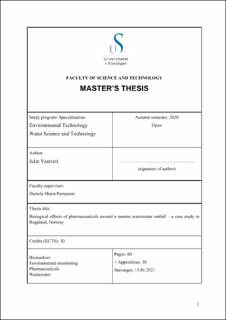| dc.description.abstract | In this thesis, farmed Mytilus edulis were caged and deployed at three locations at the coastline of the North Sea to monitor the potential biological effect related to the presence of pharmaceuticals in the marine environment. Station 1 was selected west of Kvitsøy, Rogaland, and was used as a reference location. Another site east of Kvitsøy was also included (station 2) located close to residences and an aquaculture facility. Finally, station 3 was by the wastewater outlet of IVAR.
Prior to the field deployment, a group of mussels were sampled for a time zero (T0) biological determination (pre-deployment data collection). After 1, 2, and 4 weeks of transplantation, mussels were sampled to evaluate time-integrated biological responses. A multi-biomarker approach was used to assess the biological effect on the mussels, and the different field locations were compared. The selected biomarkers were analysed: lysosomal membrane stability (LMS), evaluated by the neutral red retention time assay; catalase (CAT) activity, a measurement of oxidative stress; acetylcholinesterase (AChE), a measurement of neurotoxicity; condition index (CI), and stress on stress (SoS), the last two as physiological parameters of general health.
After 4 weeks of deployment, mussels from stations 2 and 3 had a significantly lower value ofCI, compared to station 1 and T0. For the SoS assay, a significant decrease in the median survival time was observed in mussels caged at stations 2 and 3 after 4 and 2 weeks of deployment, compared to station 1 and T0. AChE activity was significantly increased in mussels caged at station 3 after 1 week and 2 weeks of deployment compared to organisms from station 1 and T0, while station 2 organisms had significantly higher activity compared to T0 samples. After 4 weeks of translocation, organisms from all stations had significantly increased AChE activity compared to T0; however, there was no significant difference between the samples. CAT activity significantly decreased in mussels caged at for all stations after 1 week of deployment compared to T0 samples. After 2 weeks, organisms caged at station 2 had significantly lower CAT activity compared to the ones from stations 1, 3, and T0. Samples after 4 weeks of deployment were not significantly different. However, CAT activity in mussels caged at station 3 was significantly decreased in time (2 to 4 weeks).
A principal component analysis (PCA) was carried out to summarize all the biomarker responses. The PCA clearly distinguished the stations from each other, separating station 3 clearly from station 1 and T0 after 1, 2, and 4 weeks deployment. The biomarker responses at station 2 were in between stations 1 and 3 after 1 week of deployment, most similar to station 1 and T0 after 2 weeks of deployment, and after 4 weeks, more similar to station 3 responses. The overall results showed that organisms close to the wastewater outlet (station 3) were affected by the surrounding environmental conditions, while tend to compensate towards the end of the transplantation time. | en_US |
